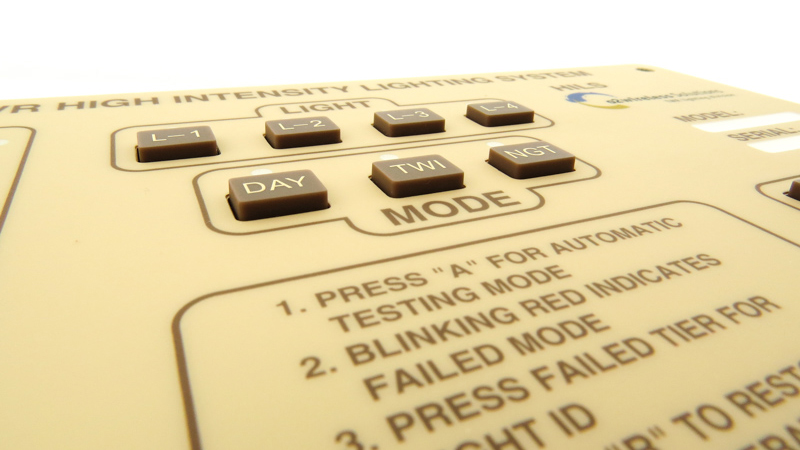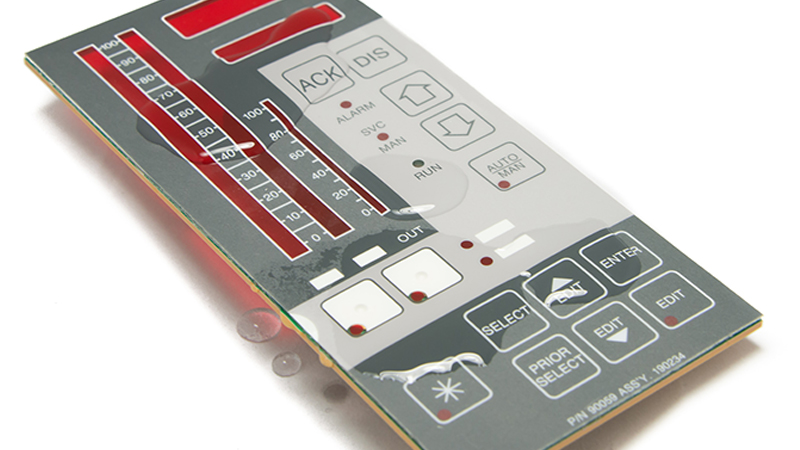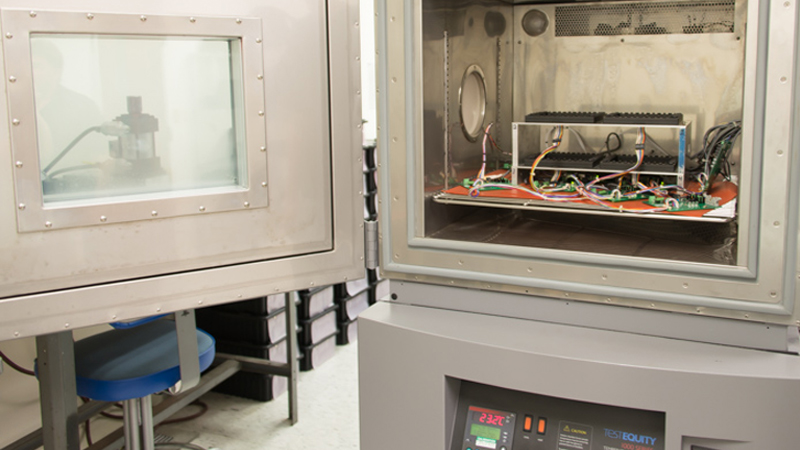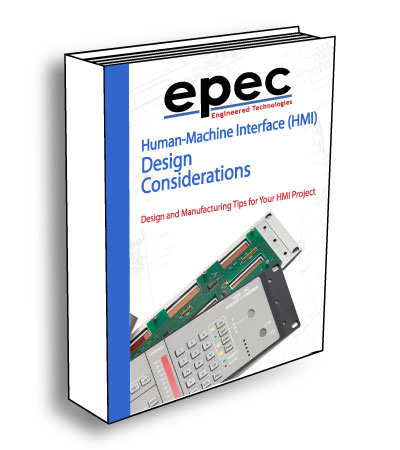Environmental Factors When Designing User Interface Assemblies
By Paul Knupke - Epec Engineered Technologies
Custom user interface assemblies are also commonly known as keypads or keyboards. However, keypads or keyboards are too narrow for a description of these human-machine interface (HMI) assemblies. End applications with user interfaces range from simple input devices to complex devices with extra capabilities such as displays and interface control electronics.
As a custom user interface designer and manufacturer, Epec reviews the OEM user interface drawings during the quoting process. Some of those drawings show a specific user interface style but the drawings do not state environmental specifications, or state any environmental specifications that are outside of the realistic capabilities for that selected style of user interface. In this article we will review the environmental categories and their impact on choosing user interface styles.
Important environmental categories for user interface assemblies include:
- Outdoor UV Exposure
- Storage and Operating Temperature Range
- Waterproof or Splash Resistance on Exposed Surfaces
- Airborne Contamination
- Chemical Contamination
- Vibration and Shock
- Electro Static Discharge (ESD) or Electro Magnetic Interference (EMI)
- Abrasion Resistance
Outdoor UV Exposure
Common plastic films used in graphic overlays on user interfaces are polyester and polycarbonate. Both films are not intended for long term exposure to outdoor UV (sunlight). UV causes yellowing and attacks the plasticizers that cause brittleness. Graphic overlays have to flex during usage in user interfaces and will quickly fracture after UV exposure. UV hardcoats are available from plastic film manufactures that adds abrasion resistance and various textures to the surface but do not filter UV.

Figure 1: Example of a human-machine interface used in an outdoor application.
One specialty film rated for UV exposure is a polyvinyl fluoride and polycarbonate composite but is not stocked by plastic film distributors because of large minimum buys from the manufacture and long lead times. Besides the problem with availability, this specialty film curls and is difficult to process during printing, cutting and laminating.
Storage and Operation Temperature Range
Almost all user interface assemblies operating in a limited temperature range such as an office or laboratory can perform as intended. Extended temperature ranges start to limit choices on adhesives, electronic component selection, and plastic films used in some user interface styles. For example, plastic films and pressure sensitive acrylic adhesives become very brittle at temperatures below freezing.
Plastic films and adhesives have to flex when switch areas are pressed. High force is required at very low temperatures to flex these layers to operate switches.
Acrylic adhesive can fracture and fail when frozen and flexed. Acrylic adhesive sheer and peel strength decreases rapidly as the ambient temperature is below freezing.
Effects of very low temperature accumulate with exposure time. Storage and operating temperatures above 65°C soften acrylic adhesives where the adhesive will "flow", move under pressure or stress that may cause visible bubbles on exterior surfaces. High storage and operating temperatures accelerate some chemical processes such as oxide formation or silver migration.
Waterproof or Splash Resistance on Exposed Surfaces
User interfaces that must withstand splashing or be completely waterproof on exposed surfaces require sealing the exposed edges. Seals must be compliant over temperature range, shock and vibration. Atmospheric pressure difference between the inside and outside of the application may cause pooled moisture entering the smallest void in the seal. Graphic overlays without any through holes in the front surface provide a good surface seal but any exposed edges are a weak point.

Figure 2: Example of a water resistant user interface assembly.
Pooled liquid on an exterior surface or edge can freeze if the temperature drops below freezing. Ice formation can further weaken seal areas due to expansion. Unfortunately, liquid entry into a user interface may include dissolved contaminates that could cause user interface failure over time.
Airborne Contamination
Airborne contamination in a user interface is similar to liquid entering the user interface mentioned above. Airborne contamination contains dust and dirt that are generally nonconductive.
When airborne contamination enters the area where the switch surfaces are located, the nonconductive contamination will cause switch deterioration such as increased contact bounce, intermittent switch closure or open switches. Airborne contamination can enter a user interface from the front, sides or rear of the assembly. Unless the assembly is 100 percent environmentally sealed, the assembly breathes during switch presses or atmospheric pressure changes. Of all of the environmental factors, airborne contamination is overlooked most by designers.
Chemical Contamination
Chemical contamination can cause obvious problems to exposed surfaces. Chemical contamination can take the form of unintended chemical splashes on the surfaces or intended exposure to common cleaning products. Chemical contamination can degrade exterior surfaces such as graphic overlay plastic film or exposed pressure sensitive adhesive at the peripheral edges of the assembly. Chemical contamination can degrade the switch contact surfaces and eventually cause catastrophic electrical failure if there is an entrance path to the switch contact surfaces.
Vibration and Shock
Vibration and shock are obvious concerns for portable or military equipment. User interface assemblies are usually low mass devices and are less susceptible to vibration and shock. However, attached hardware and connectors are easily overlooked as problem areas. Many times the connector and cable assembly that plugs into the user interface can cause connector damage on the user interface assembly when subjected to vibration and shock.

Figure 3: Example of a user interface assembly inside an environmental chamber.
Electro Static Discharge (ESD) or Electro Magnetic Interference (EMI)
ESD and EMI requirements apply to the complete application, not to just part of the application such as the user interface assembly. The only practical test method and attendant specification applies to the complete application assembly. ESD or EMI testing on the user interface assembly has little relationship to testing the complete application. However, user interface design can foster successful results but must be performed with an understanding of both the user interface assembly and the complete application.
Some styles of user interfaces are more capable of meeting ESD or EMI than other styles. Solid metal shields with proper electrical bonding to the chassis are a must. Printed silver grids or peripheral ESD "rings" on plastic film do not perform well for ESD and are virtually useless for EMI. Metal shields must be flexible when used with switches to preserve tactile feel for end users.
Abrasion Resistance
Most user interface exterior surfaces are also visual surfaces to end users. Abrasion can occur when harder surfaces come in contact with softer surfaces, such as fingernails against soft display windows or gloves contaminated with grit is pressed against a graphic overlay. Dirt and grit can also damage any sliding surface such as a rubber keytop and a bezel around a keypad.
Common approaches to minimizing abrasion damage include material selection, adding UV hardcoats to plastic film, and polyurethane coatings on molded keytops on rubber keypads.
Summary
Successful design for OEM applications using user interface assemblies must address the environmental specifications before a user interface style is chosen. Not all user interface styles can meet one or a combination of environmental requirements.
The smart choice of user interface style starts with understanding the user interface style environmental capability and matching styles with requirements. We have seen too many user interface assemblies quoted and design process far along execution when environmental specifications are identified or changed. Environmental requirements must be identified from the beginning.
Each user interface style is a combination of materials and manufacturing techniques that work together as a system. These materials and techniques cannot be adjusted independently for environmental requirements without affecting the user interface assembly's initial or long term performance. Epec has the design experience and staff to handle on OEM's HMI environmental requirements and can assist OEMs in choosing the best user interface style for their application when involved early in the development process.
Will Your Product Face the Elements?
Our team of experienced engineers is here to help you design a custom user interface assembly able to withstand the harshest environmental specifications.
Request a Quote Request Design Support


